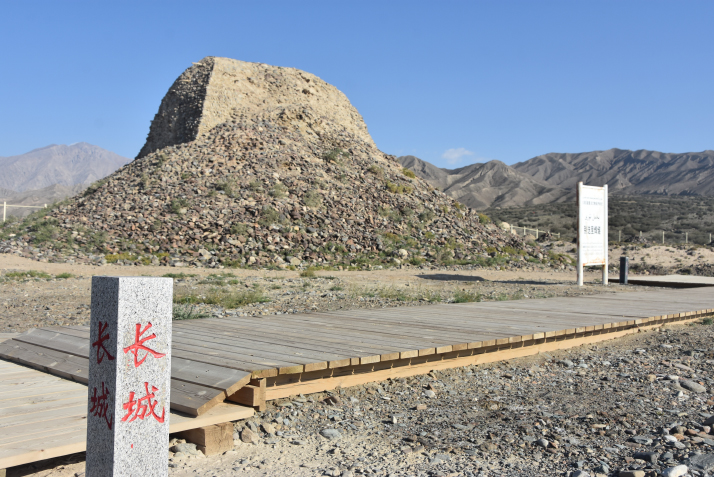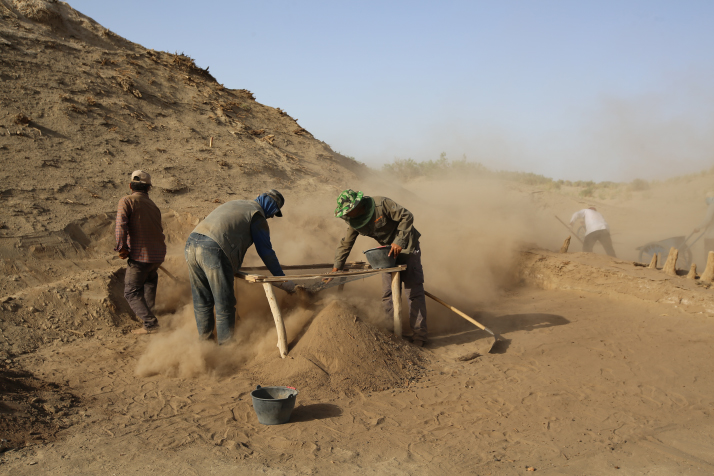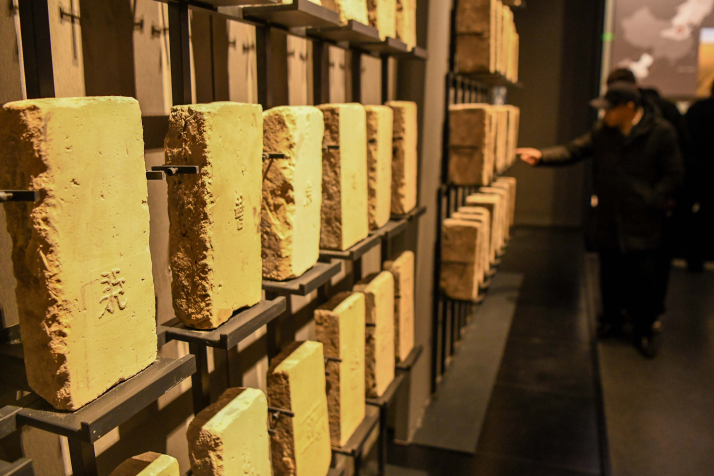| Xinjiang Today |
| The Great Wall in the Western Regions | |
|
|
 The ruins of the Biedieli Beacon Tower in Wushi County, Aksu Prefecture. It is the westernmost Great Wall beacon tower that still survives today (XINHUA)
The Great Wall stands as one of China's most iconic architectural marvels. Its origins can be traced back to the Western Zhou Dynasty (1046-771 B.C.), when beacon towers and interconnected fortifications were constructed along northern frontiers of the Central Plains as early warning systems against nomadic invasions, forming a prototype. During the Spring and Autumn Period (770-476 B.C.) and Warring States Period (475-221 B.C.), rival states built extensive walls for defense. Following the reunification of China under Emperor Qin Shihuang, who founded the Qin Dynasty (221-206 B.C.), China's first united feudal dynasty, in 221 B.C., existing walls were connected and expanded into a cohesive defensive network, creating the initial version of what would later be called the wanli changcheng or "10,000-li long wall." Li is a traditional Chinese unit of distance that equals half a kilometer. Ensuing dynasties, from the Han (206 B.C.-A.D. 220) through the Ming (1368-1644), continued to reinforce and extend these fortifications. The sections of the ancient wall most commonly associated with the Great Wall today—stretching from Hushan in Liaoning Province in northeast China to the Jiayu Pass in Gansu Province, next to Xinjiang—are mainly well-preserved remnants of the Ming Dynasty construction, winding its way approximately 8,850 km across north China.  Members of an archaeological team work at the ruins of the Kiyakkuduk Beacon Tower in Yuli County, Bayingolin Mongolian Autonomous Prefecture (XINHUA)
However, historical research reveals that the Great Wall extends far beyond the Jiayu Pass and into Xinjiang, with unique remnants there forming an integral part of China's Great Wall heritage. Dating back to the opening of the Silk Road in the Han Dynasty, Xinjiang's frontier defense system evolved as a network of strategically spaced beacon towers, garrison forts and post stations. This defensive network, following the ancient trade routes, served multiple critical functions: transmitting military signals, maintaining border security, ensuring swift governance and supporting Silk Road caravans with both provisions and protection. This northwestern extension of the Great Wall not only facilitated cultural and commercial exchange between East and West but also stands as physical evidence of effective governance by China's central authorities over the Western Regions in ancient times. The Central Plains, the part of the North China Plain surrounding the lower and middle reaches of the Yellow River, are considered the heartland of ancient China. The Western Regions are regions west of Dunhuang, Gansu Province, including today's Xinjiang. In 2019, the Xinjiang Institute of Cultural Heritage and Archaeology conducted an excavation at the Kiyakkuduk Beacon Tower site, located in an uninhabited area 90 km southeast of the Yuli County seat in Bayingolin Mongolian Autonomous Prefecture. The project yielded over 1,400 precious artifacts, which were collectively honored among China's Top 10 Archaeological Discoveries of 2022. Preliminary research identifies the Kiyakkuduk Beacon Tower as a military installation under the Yanqi Garrison—one of the Four Garrisons of the Grand Anxi Frontier Command during the Tang Dynasty (618-907). The excavation clarified the site's structural layout and unearthed military, political, economic and literary artifacts. Notably, the findings document the hierarchical military facilities along the Kongque River, filling critical gaps in historical records about the Tang frontier defense system. The discoveries provide firsthand insights into borderland governance, military administration and daily life during the Tang era. Archaeological findings reveal that Xinjiang's Great Wall system is composed of interconnected beacon towers, long walls, trenches, watchtowers, garrison stations, fortified outposts and mountain passes. Among them, beacon towers were the core defensive element. Strategically positioned along the Silk Road, these towers controlled water sources critical for caravans, diplomatic missions and military forces. The entire system followed a standardized layout: "a beacon every five li, a watchtower every 10 li, a fort every 30 li and a garrison town every 100 li." Following Han Dynasty official Zhang Qian's pioneering expeditions to the Western Regions that opened the Silk Road, successive dynasties constructed this network of military installations across Xinjiang's oases to safeguard the northwestern frontier. During the Han Dynasty, the Great Wall defenses in Xinjiang primarily aligned with the northern and southern corridors of the Silk Road. Remains are concentrated across present-day Yuli, Ruoqiang and Qiemo counties in Bayingolin. Additional ones are found near the administrative heartland of the ancient Western Regions Frontier Command set up in the Han Dynasty, in today's Luntai County in Bayingolin as well as in Kuche (Kuqa) City and Baicheng County in neighboring Aksu Prefecture.  Visitors examine bricks used to build the Great Wall at a museum in Yuli County in December 2023 (XINHUA)
During the Tang Dynasty, Xinjiang's Great Wall defenses formed three distinct beacon tower chains along the Silk Road and through key administrative centers. The southern route stretched from Dunhuang to Shanshan County in Turpan City and Yutian County and Hetian (Hotan) City in Hetian Prefecture before turning north to Shule County in Kashi (Kashgar) Prefecture, where it converged with the central route. The central route began at Hami City, traversing Turpan City, Yanqi Hui Autonomous County in Bayingolin, Kuche and Shule, before crossing the Pamir Plateau. The northern route originated in Yiwu County in Hami, extending westward through Balikun (Barkol) Kazak Autonomous County in Hami, Jimusaer (Jimsar) County in Changji Hui Autonomous Prefecture, Luntai County in Bayingolin and Gongliu County in Ili Kazak Autonomous Prefecture into Central Asia. During the Qing Dynasty (1644-1911), Xinjiang's frontier defense system primarily radiated from two strategic hubs: Hami in the east and Kashi in the west. Following the empire's reunification of the region, authorities revitalized existing beacon towers and military posts while establishing new garrison stations and courier posts. This created an integrated transportation network stretching from Xingxingxia in Hami in the east to Ili in the west, extending southwestward to Kashi, southward to Hetian and northward to Tacheng Prefecture—effectively bridging the Tianshan Mountains' northern and southern territories. Notably, during the Yongzheng (1723-1735) and Qianlong (1736-1796) reigns, the Qing government constructed numerous frontier outposts. These multifunctional installations—serving as watchtowers, garrison points and tax collection stations—were deployed in Balikun, Tacheng, Altay, Ili, Kashi and Hetian. Archaeological surveys identify 212 Great Wall sites across Xinjiang, distributed in 10 of its 14 prefecture-level divisions. On November 2, 2019, the Digital Museum of the Great Wall of China opened in Qinhuangdao, Hebei Province, known for the Shanhai Pass, once regarded as the eastern starting point of the Ming Dynasty Great Wall. For the first time, it launched an exhibition on the Great Wall in Xinjiang, which traced the ancient defensive network from the Jiayu Pass westward through Xinjiang's Hami, Turpan, Aksu, Kashi and Kizilsu Kirgiz Autonomous Prefecture. Another milestone, the Great Wall National Cultural Park opened in Yuli on December 29, 2023. The park showcases 11 beacon tower sites, including the renowned Kiyakkuduk Beacon Tower ruins. Both venues serve as portals for understanding Xinjiang's Great Wall heritage. The alignment of the Great Wall remnants in Xinjiang and Gansu so closely with the ancient Silk Road routes suggests that their function and purpose were different from those of other sections to the east. While they performed a role in border protection, these westernmost sections of the Great Wall performed a greater role in protecting and supporting international caravans, securing the Silk Road trade routes from central China into Central Asia. The Book of Han, which covers the history of the Western Han Dynasty (206 B.C.-A.D. 25), preserves the earliest textual evidence of Xinjiang's Great Wall construction. It documents Emperor Wudi establishing four frontier administrative districts in modern Gansu in 111 B.C. These prefectures were the primary eastern gateway from Xinjiang to Chang'an, now Xi'an, the Han capital and one of the Silk Road's key arteries. From Jiuquan—the westernmost of the four—the emperor ordered the construction of fortified outposts extending toward present-day Xinjiang. In 60 B.C., the Western Han Dynasty consolidated its control over territories spanning both sides of the Tianshan Mountains in present-day Xinjiang, establishing the Western Regions Frontier Command as its military-administrative authority. Emperor Xuandi subsequently ordered the construction of a beacon tower network stretching from Lop Nur westward to Quli (modern Korla), marking the initial formation of Xinjiang's Great Wall system. During the Tang Dynasty, imperial authorities expanded this defensive infrastructure to strengthen governance of the Western Regions while enhancing connectivity between the Anxi and Beiting frontier commands and their subordinate prefectures. Whether under the Tang or subsequent dynasties, governance of the Western Regions largely preserved the Han-era administrative framework. Xinjiang's Great Wall evolved beyond pure military defense, maintaining its dual role as both territorial safeguard and logistical corridor. Unlike its eastern counterparts designed primarily to repel invasions, Xinjiang's Great Wall operated on principles of openness and connectivity. Functioning as both protective shield and diplomatic corridor, it safeguarded prosperity in the Western Regions, ensured the smooth operation of the Silk Road and maintained national security through adaptive governance. Comments to lanxinzhen@cicgamericas.com |
|
||||||||||||||||||||||||||||
|